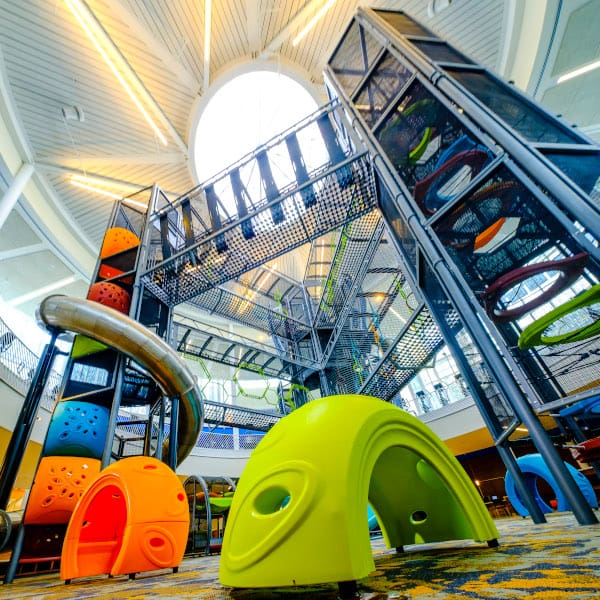The Future of Movie Theaters: Can Movie Theaters Survive?

The Future of Movie Theaters: Can Movie Theaters Survive?
Movie theaters struggled with the changes brought about by the pandemic. With a rich history and an uncertain future, movie theaters must adapt strategies to stay in business and compete with streaming services.
Jump to a specific section:
- The History of Movie Theaters and Cinema
- Statistics of Movie-Goers
- What People Love About Movie Theaters
- How to Attract More People to Your Movie Theater
- Make Your Theater An Event With Soft Play
The History of Movie Theaters and Cinema
The history of movie theaters and film in the United States is robust. As the home of entertainment in Hollywood, the U.S. has produced classics and new favorites every year. Let’s take a look at how film has evolved:
- The first movie theater: The first movie theater in the U.S. — The Nickelodeon — opened on June 19, 1905, in Pittsburgh, Pennsylvania. You can break its name down into two essential parts. The nickel represents the cost of admission to see shows, while “odeon” is the Greek word for theater.
- The first drive-in movie theater: A staple of the 1950s, the first drive-in movie theater opened on June 6, 1933, in Camden, New Jersey. The emergence of the drive-in highlights how the industry changed to cater to customer convenience. Viewers could enjoy movies from the comfort of their cars while still getting to leave the house and enjoy their favorite movie snacks.
- The first movie with sound: Silent films were popular when cinema was new. As technology improved, filmmakers figured out how to sync sound and moving pictures, resulting in movies with sound. “The Jazz Singer” was the first movie released with sound in 1927, marking a new era of movie experiences called “talkies.”
- The introduction of color: Many filmmakers started experimenting with color to enhance cinematography and expand movie theater experiences. “The Wizard of Oz” includes one of the most famous color reveals in cinematic history, starting in traditional black and white and transitioning to bright, vibrant colors when Dorothy lands in Oz. This experience shocked and impressed viewers who saw this movie in theaters. The film released on August 25, 1939.
- The establishment of at-home entertainment: While people have always loved going to the movie theater with friends and family, technology allowed them to enjoy their favorite movies from the comfort of home. Video home systems (VHS) were released in the U.S. in 1977, enabling people to watch movies on cassette tapes so that they could watch their favorites anytime they wanted.
- The improvement of at-home entertainment: Multiple technology companies worked together to create DVDs in 1995 as a more compact, transportable and easy-to-use method of home entertainment. DVDs eliminated the need to rewind tapes and offered better-quality visuals. CDs could also hold extra content, like director’s cuts and bloopers, adding to the movie-watching experience. The movie industry would release CDs after films left theaters, so they could continue to optimize initial and merchandise sales.
- The introduction of streaming: Netflix changed the movie business with the launch of its streaming service in 2007. Movie rentals were not unique to Netflix — they just streamlined the service. Prior to streaming, audiences could still rent films. Blockbuster opened in 1985, allowing people to rent their favorite shows and movies. Netflix started in 1998 by mailing movies to customers. Streaming enabled people to watch more content without waiting or buying it. They could access the whole database with their subscription, changing the industry forever.
Today, individuals can choose from several streaming services with unique content and watching experiences. Netflix has its signature binge-worthy content that releases simultaneously, while other platforms like Hulu and HBOMax offer weekly episodes for a more traditional feel.
Statistics of Movie-Goers
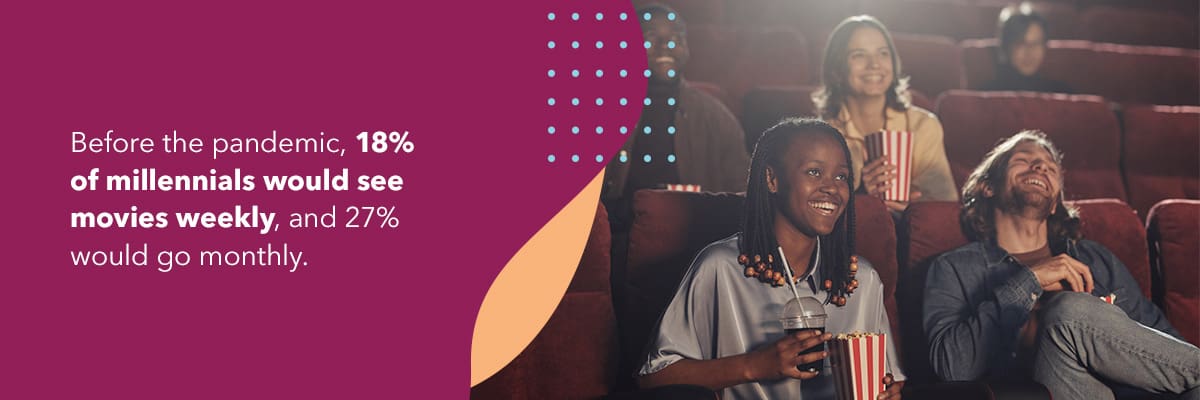
As history and technology change, movie theater audiences shift as well. In response to COVID-19 and other market factors, movie-goers have new patterns that theaters must understand to stay in business. You can help improve the future of movie theaters by knowing who most frequently visits them.
Millennials make up the largest population of movie-goers. Before the pandemic, 18% of millennials would see movies weekly, and 27% would go monthly. While this percentage dropped after the pandemic, this group still made up a significant portion of movie-goers. Around 8% of millennials went to the movies weekly, and 17% still went monthly.
Gen Z, the generation below millennials, improved their monthly watching habits during the pandemic, with 19% going to the movies. Together, these groups averaged around 3.2 films watched in theaters during 2021.
Knowing what ages frequent your movie theater the most can help you develop strategies that best meet their interests for improved experiences and increased retention rates. You can create goals to expand your audience to include those you aren’t reaching.
What Do People Love About Movie Theaters?

You can better understand your audiences by learning their motivations for going to the movies, which can drive marketing campaigns for new products or services. When you are competing with other movie theaters and streaming services, it’s important to remember what makes a movie theater special:
- Technological improvements: Watching movies on laptops, tablets and smartphones can be convenient, but movie theaters provide better audio and visual quality. People looking for a premier watching experience often choose to go to the movie theater.
- Social experiences: People can use movie theaters to host several social events. From couples on dates to friends looking for a group activity, movie theaters and their diverse selections can support all social experiences. Many people go to movie theaters for their birthdays or other special events. Some people like to enjoy content they love in the presence of other fans, like when watching Marvel or Star Wars movies.
- Exclusivity: Even with the increasing popularity of streaming services, many filmmakers exclusively release their movies to movie theaters before making them available online. Exclusivity draws more viewers to movie theaters, so they can view movies before they see spoilers online. Theater exclusivity is a great way to draw people to your location, especially when many fans wait so long for new releases.
Regardless of your theater’s specific demographic, knowing what makes movie theaters unique and appealing to individuals can help you improve your services. Whether you enhance what they already love or want to add something that will increase their experience, learning customer motivations can help you accomplish several goals.
Movie Theater Industry FAQ
With the aftermath of the COVID-19 pandemic changing customer behavior and preferences, many movie theaters face uncertainty. Getting answers to common questions can help you adjust your strategy to help improve the future of the movie theater industry.
1. Are Movie Theaters a Losing Business?
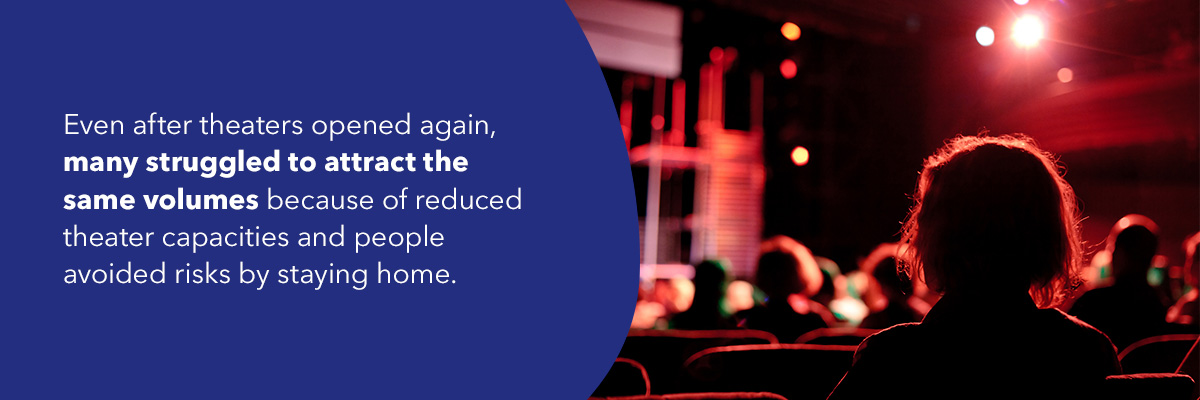
The movie industry continues to evolve with new technology and customer preferences, but recent hardships have made business more challenging for movie theaters. The COVID-19 pandemic forced many movie theaters to close down temporarily to accommodate new regulations. Even after theaters opened again, many struggled to attract the same volumes because of reduced theater capacities and people avoided risks by staying home.
As a result, many movie theaters have permanently closed, and several chains are going out of business. To preserve their long history, movie theaters must adapt to prevent them from experiencing further losses.
2. What Challenges Are Movie Theaters Facing?
Movie theaters are facing lows in audience level and movie releases. In 2007, the average person aged 18-29 saw 9.1 movies in theaters. In 2021, the same demographic only saw around 3.2. Out of the general population, approximately 61% of people admitted to not seeing any movies in 2021. With the emergence of more streaming services and the lingering effects of the COVID-19 pandemic, some of the unique challenges movie theaters deal with include:
- Maintaining audience levels: COVID-19 shutdowns and social distancing drastically lowered movie theaters’ attendance. Social distancing efforts reduced theater capacities, forcing theaters to limit how many people could see each movie even after restrictions lifted. Now, many theaters are struggling to reach old audiences and remind them why they love watching movies in theaters.
- Competing with streaming services: Emerging and successful streaming services open a new competition for movie theaters. With apps like Netflix and Hulu, people can watch their favorite movies as often as they want from the comfort of their homes. Many wait for films to release on streaming services instead of paying to see them in theaters.
- Showing fewer movies: COVID-19 delayed many projects, making reopening movie theaters slower when there were fewer ready movies to show. Additionally, the pandemic-era popularity of streaming led many companies to release films right to their apps instead of having a theater-exclusive period first. When individuals can see movies right away at home, they are less likely to go to their local theater.
3. Will Movie Theaters Die With Malls?

Malls are becoming less popular as more people shop online for increased convenience and selections. Because of decreased traffic, many malls experienced store closures and reduced hours after the pandemic. However, many individuals still rely on malls to return items, try on clothes and complete extensive shopping trips in one place. Malls also provide excellent dining facilities and social experiences.
Movie theaters and malls must adjust strategies to stay in business when competing with online spaces.
4. Are Movie Theaters Still Profitable?
During the pandemic, the movie theater industry saw a decrease in profits. Because of mandated closes and fewer produced movies, people turned to other forms of entertainment, like streaming services. Out of the $80.8 billion earned in the film industry in 2020, movie theaters only made 15% of those profits.
Can movie theaters survive? The future of movie theaters is still salvageable. The right strategies and improvements can encourage customers to return and spend money at your facilities for more revenue.
How to Attract More People to Your Movie Theater
Your movie theater can get creative to attract new and existing audiences. Keeping your visitors engaged with new features can keep them returning more frequently and catch the attention of people who wouldn’t usually go to the movies.
1. Offer Movie Passes and Subscriptions

When your customers are worried about the price of movies, subscriptions and movie passes can help match their demand and budget needs. In the age of subscriptions, you can offer a movie pass for your theater. Account holders can pay a monthly or annual fee to see a set amount of movies. You might also include other benefits, like points systems for food or an extra screening. For frequent movie-goers, this might be the payment option that meets their needs.
As you create your movie passes and subscriptions, you can reach more people by offering different levels. This option can allow various audiences to sustain their participation without committing to more movies than they would realistically see. Tiers can also help people understand how cost-effective higher options can be.
2. Cater Events With Packages and Theater Rentals
Movie theaters are an experience that improves sound and visual quality. You can enhance this benefit by offering event packages. Birthdays, parties and other events can provide business in several ways. People will come to see a movie, increasing your audience. Guests can introduce new individuals to your services. Catering or food packages can boost concessions stands. Groups might opt to rent out theaters for a more intimate and social watching experience.
4. Provide Social Watching Experiences

Many people love the movie theater for the social experience. Whether going with friends or watching with fellow fans, it is an excellent place for people to enjoy something they love together. You can expand your social experiences by offering viewings designed for social interaction. For example, people love seeing “The Rocky Horror Picture Show” because of how people interact with the movie.
You can show more movies that encourage engagement for a different movie-watching experience, from that Halloween classic to Marvel screenings and Friends marathons. These screenings can allow people to talk during movies, interact with other fans and get the visual and auditory experience they love about the film.
5. Show Movie Series
Movie theaters are about the watching experience and the movie playing. Many fans dedicate themselves to their favorite franchises and would love to experience them in theaters again. You can create frequent visitors and increase audiences by offering movie showings for fan-favorite series. Marvel, Lord of the Rings, Harry Potter and Star Wars are just some examples. Younger fans can witness these movies on the big screen for the first time, while long-time ones can relive the initial screening experience.
You can also create themed showings or event series. For example, you might show movies from a particular director, like Wes Anderson, or animation studios, like Studio Ghibli. You can increase the fun by offering marathons for films starring the same actor, even if they don’t relate to each other. While people love franchises, they also love art and their favorite creators. You can draw more crowds by creating opportunities to interact with their preferred art style, story type and actors.
6. Host Premiers
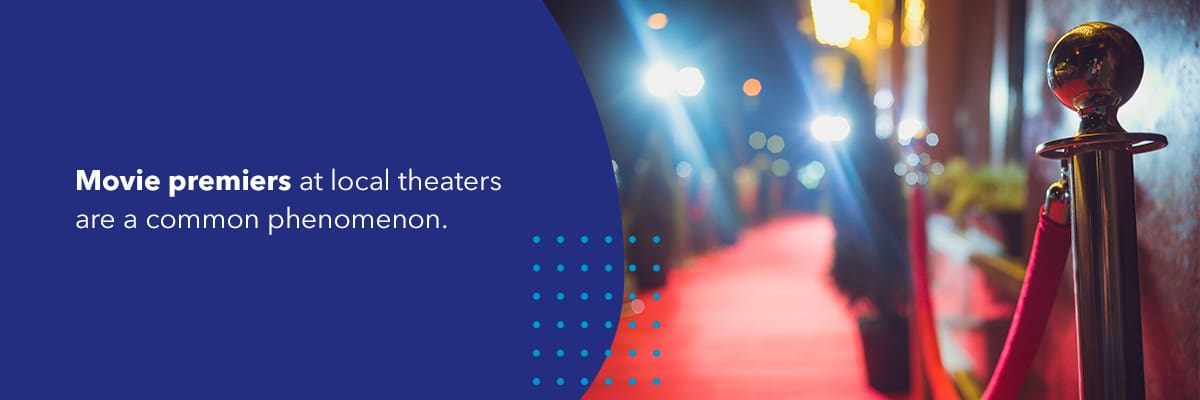
When a new movie releases, part of the excitement comes from finally seeing it for the first time and seeing how it translates to the big screen. These movie experiences are memorable for many people, and you can increase the excitement by hosting movie premiers for popular franchises and movies.
Movie premiers at local theaters are a common phenomenon. Popular series like Twilight and Star Wars hosted fan premiers where theaters would decorate their lobbies and encourage fans to dress up and watch the movie together at midnight. Fans can feel they got a true first look at the media they have been waiting for and increase their experience at your movie theater.
Especially when you want to increase customer loyalty and retention, offering events like this can show you care about your customers’ interests and want to make watching movies special. Midnight viewings also have limited seating, helping promote a higher demand for your products and further engage your visitors.
7. Serve Other Markets
When movie theaters experience decreased audiences, you can use the available space to reach new markets. Movie theaters provide adequate seating and quality visual and audio effects that can serve various audiences and purposes. Some other audiences you can consider marketing to include:
- Corporate: You can rent out theaters to corporate businesses so that they can host presentations and meetings in these spaces. With comfortable seating and excellent visual effects, companies can expand their in-person presentation quality by hosting them at movie theaters. More seats can help executive teams interact with multiple departments at once. The change in environment can also increase employee engagement during presentations for better results.
- Academic: Universities can also use theaters to assist with presentations. Various departments can use spaces to support student and faculty research presentations. Many universities host visiting professors from other schools to share their research and publications, so schools can use theaters to increase presentation experience. Graduate students can present their thesis and defend their dissertations in theaters to benefit from visual and auditory effects.
- Creative: Creative communities need spaces to share their works. Amateur filmmakers can host premiers for their movies and show them on the big screen to feel like Hollywood. Movie theaters can rent spaces to film clubs and makers or advertise showings for the public. Creatives can strive to improve their work, and seeing them in the movie theater can motivate them to improve and keep working.
Expanding your audience to additional markets can increase traffic at your movie theater. Catering to these audiences can help your movie theater better adapt to a changing market and demand.
8. Invest in New Attractions
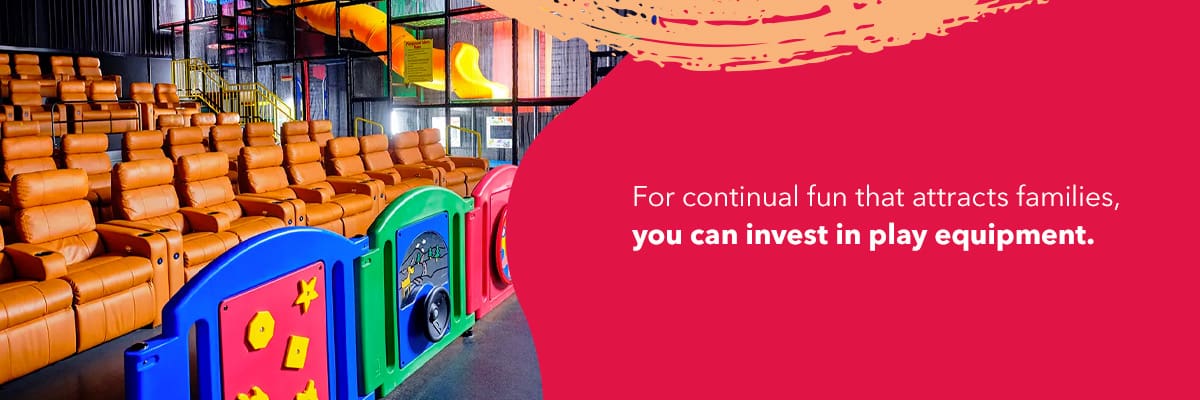
You can encourage customers to check out your movie theater and continue returning with your investments and attractions. These features can make your movie theater unique and help establish how you are different from others in the area. Attractions that can enhance your movie theater can be permanent or temporary and might include:
- Movie merchandise: Many movie theaters use relevant decorations to get their visitors excited about current movies. You can expand your merchandise beyond movie posters and offer cardboard cutouts of characters or popcorn buckets and soda cups. Movie-goers can take pictures with visual merchandise, while consumables can come free with ticket or concessions purchases. These attractions can excite people about your movies and encourage them to return for future promotions.
- Holiday decorations: Holiday and seasonal decorations can make your movie theater plaza exciting each time your visitors come to the movies. While your lobby might seem like an ambient space where customers only pass through, customers can spend a lot of time there purchasing tickets and waiting for food. Making spaces exciting and customizable can make these areas more enjoyable for customers as they wait.
- Musical instruments: Malls and other entertainment spaces often use musical instruments and performers to create the environment they want. When investing in a musical feature, you have several options. Self-playing instruments can provide consistent music while engaging curious kids. You can also support local musicians by inviting them to play in your lobby on the weekends. Like decorations, music can help engage customers before and after movies for a more pleasant experience.
- Play equipment: For continual fun that attracts families, you can invest in play equipment. Indoor play equipment or immersive interactive experiences can provide kids with a place to interact with family and friends. In movie theaters, they can help improve retention for families with kids because kids will ask to return to the movie theater to play. Play opportunities before and after movies can help kids get energy out. Custom equipment and unique designs can help your movie theater stand out.
Your investments can help attract different audiences and maintain your existing audience. Launching new features can help increase traffic at your movie theater, and adaptable features can keep your audience engaged and interested to see what you can offer during that visit.
Make Your Theater an Event With Soft Play Playground Equipment
When you want to attract families and kids to your movie theater, Soft Play can provide you with the quality playground equipment you need. As experts in indoor play equipment for the entertainment industry, our teams can pair you with options that will boost retention and target new visitors. Our free design consultations can allow your movie theater to receive the right equipment for your space for optimized investments.
Request a quote today and discover how we can help your movie theater adapt to the film industry’s future.

